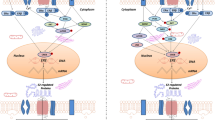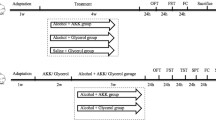Abstract
The Xiaoyaosan (XYS) decoction, a Chinese traditional prescription containing eight commonly used herbs, has been used for treatment of mental disorders such as depression for centuries in China. However, the mechanism underlying its antidepressant activity is poorly understood. In rats with chronic immobilization stress (CIS), we examined the effects of the XYS decoction on tail suspension behavior and the levels of brain-derived neurotrophic factor (BDNF), tyroxine hydroxylase (TrkB), and neurotrophin 3 (NT-3) in the frontal cortex and hippocampus. Rats subjected to CIS exhibited decreases in weight-gain, food intake, and ambulation in the open field test; they also showed an increase in immobility in the tail suspension test. These were all attenuated by the XYS decoction. Biochemically, the XYS decoction also reversed CIS-induced decreases in BDNF and increases in TrkB and NT-3 in the frontal cortex and the hippocampal CA1 subregion. The behavioral effects of the XYS were correlated to the biochemical actions. These results suggest that the XYS decoction produces an antidepressant-like effect, which appears to be involved by BDNF in the brain.





Similar content being viewed by others
References
Altemus KL, Lavenex P, Ishizuka N, Amaral DG (2005) Morphological characteristics and electrophysiological properties of CA1 pyramidal neurons in macaque monkeys. Neuroscience 136:741–756
Amelia RN, Tony H, Ronald R, Patrick K, Russo N (2001) Physical activity—antidepressant treatment combination: impact on brain-derived neurotrophic factor and behavior in an animal model. Behav Brain Res 120:87–95
Bachmann RF, Schloesser RJ, Gould TD, Manji HK (2005) Mood stabilizers target cellular plasticity and resilience cascades: implications for the development of novel therapeutics. Mol Neurobiol 32:173–202
Bartoletti A, Cancedda L, Reid SW, Tessarollo L, Porciatti V, Pizzorusso T, Maffei L (2002) Heterozygous knock-out mice for brain-derived neurotrophic factor show a pathway-specific impairment of long-term potentiation but normal critical period for monocular deprivation. J Neurosci 22:10072–10077
Chen FK, Meng XS, Guo YZ, Kano Y (1992) The identification and determination of marker substances in xiaoyao wan by three dimensional HPLC. Yao Xue Xue Bao 27:853–857
Chen JX, Li W, Zhao X, Yang JX, Xu HY, Wang ZF, Yue GX (2004) Changes of mRNA expression of enkephalin and prodynorphin in hippocampus of rats with chronic immobilization stress. World J Gastroenterol 10:2547–2549
Chen JX, Ji B, Lu ZL, Hu LS (2005a) Effects of chai hu (Radix Burpleuri) containing formulation on plasma β-endorphin, epinephrine and dopamine in patients. Am J Chin Med 33:737–745
Chen J, Zhao X, Yue G, Xu H (2005b) Changes of CRF, POMC, ENK, Pro-DYN, BDNF, and NT3 in rat brain response to chronic immobilization stress: with effects of Chinese herbs. 2005 Abstract Viewer/Itinerary Planner. Society for Neuroscience, Washington, DC, Online
Conover JC, Erickson JT, Katz DM, Bianchi LM, Poueymirou WT, McClain J, Pan L, Helgren M, Ip NY, Boland P et al (1995) Neuronal deficits, not involving motor neurons, in mice lacking BDNF and/or NT4. Nature 375:235–238
Duman RS, Heninger GR, Nestler EJ (1997) A molecular and cellular theory of depression. Arch Gen Psychiatry 54:597–606
Fujioka T, Fujioka A, Endoh H, Sakata Y, Furukawa S, Nakamura S (2002) Materno-fetal coordination of stress-induced Fos expression in the hypothalamic paraventricular nucleus during pregnancy. Neuroscience 118:409–415
Fumagalli F, Racagni G, Colombo E, Riva MA (2003) BDNF gene expression is reduced in the frontal cortex of dopamine transporter knockout mice. Mol Psychiatry 8:898–899
Jang MH, Shin MC, Lim BV, Chung JH, Kang HS, Kang SA, Choue RW, Kim EH, Kim CJ (2002) Nicotine administration decreases nitric oxide synthase expression in the hypothalamus of food deprived rats. Neurosci Lett 322:29–32
Kim J, Yoon K (1998) Stress: metaplastic effects in the hippocampus. Trends Neurosci 21:505–509
Kuroda Y, McEwen BS (1998) Effect of chronic restraint stress and tianeptine on growth factors, growth-associated protein-43 and microtubule-associated protein 2 mRNA expression in the rat hippocampus. Brain Res. Mol Brain Res 59:35–39
Lindsay RM, Wiegand SJ, Altar CA, DiStefano PS (1994) Neurotrophic factors: from molecule to man. Trends Neurosci 17:182–190
Maroun M, Richter-Levin G (2003) Exposure to acute stress blocks the induction of long-term potentiation of the amygdala-prefrontal cortex pathway in vivo. J Neurosci 23:4406–4409
McEwen BS (2005) Glucocorticoids, depression, and mood disorders: structural remodeling in the brain. Metabolism 54(5 Suppl 1):20–23
Nibuya M, Takahashi M, Russell DS, Duman RS (1999) Repeated stress increases catalytic TrkB mRNA in rat hippocampus. Neurosci Lett 267:81–84
Pang PT, Lu B (2004) Regulation of late-phase LTP and long-term memory in normal and aging hippocampus: role of secreted proteins tPA and BDNF. Ageing Res Rev 3:407–430
Pezawas L, Verchinski BA, Mattay VS, Callicott JH, Kolachana BS, Straub RE, Egan MF, eyer-Lindenberg A, Weinberger DR (2004) The brain-derived neurotrophic factor val66met polymorphism and variation in human cortical morphology. J Neurosci 24:10099–10102
Qin XS, Jin KH, Ding BK, Xie SF, Ma H (2005) Effects of extract of Ginkgo biloba with venlafaxine on brain injury in a rat model of depression. Chin Med J (Engl) 118:391–397
Rage F, Givalois L, Marmigere F, Tapia-Arancibia L, Arancibia S (2002) Immobilization stress rapidly modulates BDNF mRNA expression in the hypothalamus of adult male rats. Neurosci 112:309–318
Siuciak JA, Lewis DR, Wiegand SJ, Lindsay RM (1997) Antidepressant-like effect of brain-derived neurotrophic factor (BDNF). Pharmacol Biochem Behav 56:131–137
Smith MA, Makino S, Kvetnansky R, Post RM (1995) Stress and glucocorticoids affect the expression of brain-derived neurotrophic factor and neurotrophin-3 mRNAs in the hippocampus. J Neurosci 15(3 Pt 1):1768–1777
Xu H, Qing H, Lu W, Keegan D, Richardson JS, Chlan-Fourney J, Li XM (2002) Quetiapine attenuates the immobilization stress-induced decrease of brain-derived neurotrophic factor expression in rat hippocampus. Neurosci Lett 321:65–68
Yun SJ, Park HJ, Yeom MJ, Hahm DH, Lee HJ, Lee EH (2002) Effect of electroacupuncture on the stress-induced changes in brain-derived neurotrophic factor expression in rat hippocampus. Neurosci Lett 318:85–88
Acknowledgements
Gratitude is expressed to Dr. Hangting Zhang who works at West Virginia University for editing the manuscript. This research was supported by research grants from the National Natural Science Foundation of China (No. 30672578, 30000216), Specialized Research Fund for the Doctoral Program of Higher Education (No. 20060026001), the Teaching and Research Award Program for Outstanding Young Teachers in Higher Education Institutions of MOE, P.R.C., Fok Ying Tong Education Foundation (No. 81037), and Foundation for the Authors of National Excellent Doctoral Dissertations of China (No. 200059) to Jia-Xu Chen.
Author information
Authors and Affiliations
Corresponding author
Rights and permissions
About this article
Cite this article
Chen, JX., Li, W., Zhao, X. et al. Effects of the Chinese Traditional Prescription Xiaoyaosan Decoction on Chronic Immobilization Stress-induced Changes in Behavior and Brain BDNF, TrkB, and NT-3 in Rats. Cell Mol Neurobiol 28, 745–755 (2008). https://doi.org/10.1007/s10571-007-9169-6
Received:
Accepted:
Published:
Issue Date:
DOI: https://doi.org/10.1007/s10571-007-9169-6




